Hungerford T.W., Shaw D.J. Contemporary Precalculus: A Graphing Approach
Подождите немного. Документ загружается.


Equation Method
Replace the second equation by the
sum of itself and 2 times the first
equation:
x 2y 3z 2
2y 5z 6
3x 3y 10z 2
Replace the third equation by the sum of
itself and 3 times the first equation:
x 2y 3z 2
2y 5z 6
3y z 4
Multiply the second equation by 1/2
(so that y has coefficient 1):
x 2y 3z 2
y
5
2
z 3
3y z 4
Replace the third equation by the sum
of itself and 3 times the second equa-
tion:
x 2y 3z 2
y
5
2
z 3
1
2
3
z 13
Finally, multiply the last equation by
2/13:*
x 2y 3z 2
(
**
) y
5
2
z 3
z 2
796 CHAPTER 11 Systems of Equations
Matrix Method
Replace the second row by the sum of
itself and 2 times the first row:
12 3 2
0256
33 10 2
Replace the third row by the sum of
itself and 3 times the first row:
1232
0256
0 31 4
Multiply the second row by 1/2:
12 32
01
5
2
3
0 31 4
Replace the third row by the sum of
itself and 3 times the second row:
12 3 2
01
5
2
3
00
1
2
3
13
Finally, multiply the last row by
2/13:
12 3 2
01
5
2
3
00 1 2
*This step isn’t necessary, but it is often convenient to have 1 as the coefficient of the first variable in
each equation.
entries in the first and second columns 0. Here is a side-by-side development of
the two solution methods.

System (
**
) is easily solved. The third equation shows that z 2, and substi-
tuting this in the second equation shows that
y
5
2
(2) 3
y 3 5 2.
Substituting y 2 and z 2 in the first equation yields
x 2(2) 3(2) 2
x 2 4 6 8.
Therefore, the only solution of the original system is x 8, y 2, z 2. ■
When using matrix notation, row operations replace elementary operations
on equations, as shown in Example 3. The solution process ends when you reach
a matrix, (and corresponding system), such as the final matrix in Example 1:
12 32 x 2y 3z 2
(
**
)
01
5
2
3
y
5
2
z 3
00 12 z 2.
The final matrix should satisfy these conditions:
All rows consisting entirely of zeros (if any) are at the bottom.
The first nonzero entry in each nonzero row is a 1 (called a leading 1).
Each leading 1 appears to the right of leading 1’s in any preceding rows.
Such a matrix is said to be in row echelon form.
Most calculators have a key that uses row operations to put a given matrix
into row echelon form (see the Technology Tip in the margin). For example, using
the TI-84 REF key on the first matrix in Example 3 produced this row echelon
matrix and corresponding system of equations.
11
1
3
0
2
3
x y
1
3
0
z
2
3
01
1
1
7
2
5
6
y
1
1
7
2
z
5
6
00 1 2 z 2.
Because the calculator used a different sequence of row operations than was used
in Example 3, it produced a row echelon matrix (and corresponding system) that
differs from matrix (
**
) above. You can easily verify, however, that the preceding
system has the same solutions as system (
**
), namely,
x 8, y 2, z 2.
EXAMPLE 4
Solve the system
x y 2z 1
2x 4y 5z 2
3x 5y 7z 4.
SECTION 11.2 Large Systems of Linear Equations 797
TECHNOLOGY TIP
To put a matrix in row echelon form,
use REF in this menu/submenu:
TI-84: MATRIX/MATH
TI-86: MATRIX/OPS
TI-89: MATH/MATRIX
Casio and HP-39gs users should con-
sult the Technology Tip after Example 5.
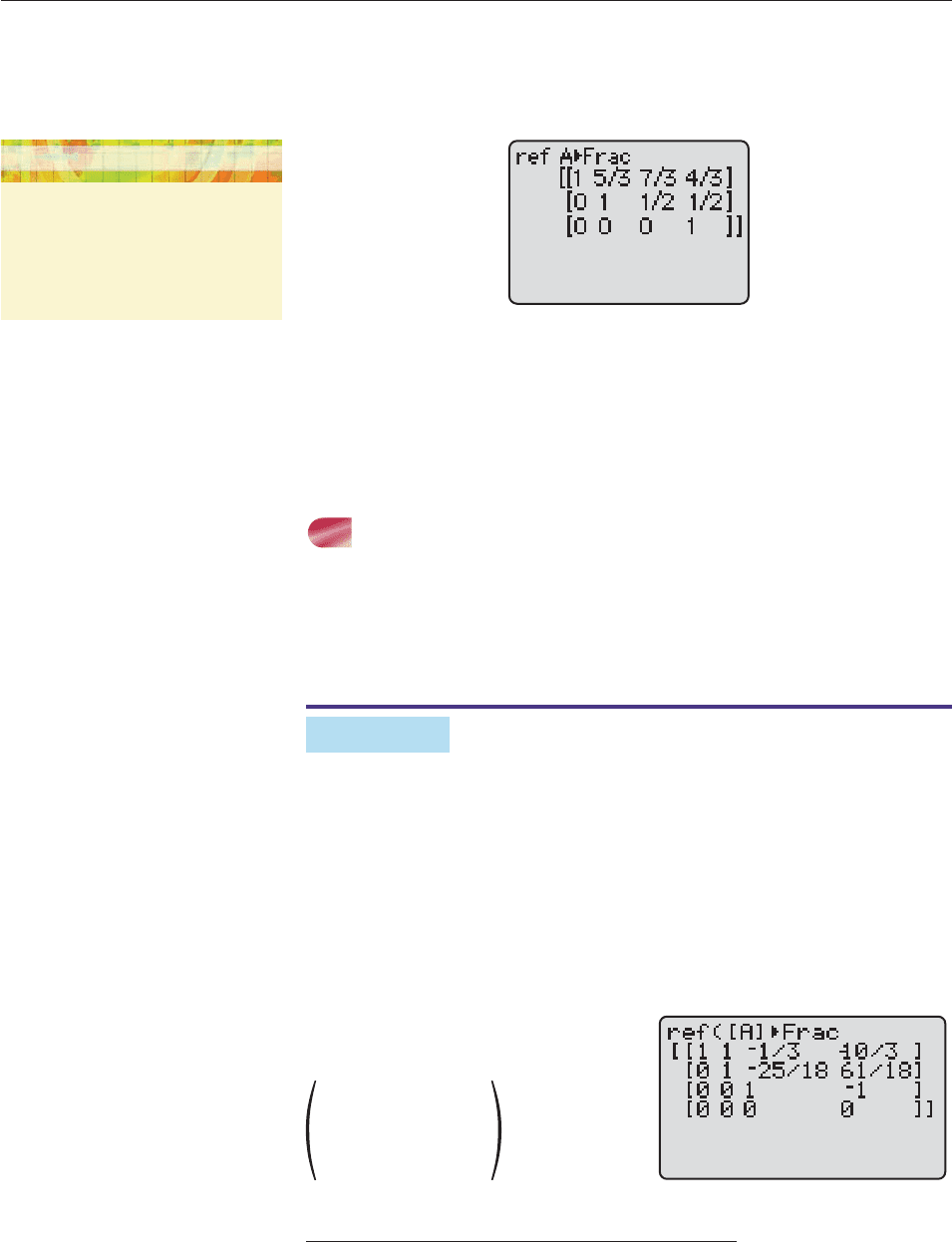
SOLUTION If you try to use a systems equation solver on a calculator, you
may get an error message. So we form the augmented matrix and reduce it to row
echelon form either by hand or by using the REF key. A TI-86 produced the row
echelon matrix in Figure 11–17.
Figure 11–17
Look at the last row of the matrix in Figure 11–17; it represents the equation
0x 0y 0z 1.
Since this equation has no solutions (the left side is always 0 and the right side
is always 1), neither does the original system. Such a system is said to be incon-
sistent. ■
THE GAUSS-JORDAN METHOD
Gaussian elimination on a calculator is an efficient method of solving systems of
equations but may involve some messy calculations when you solve the final tri-
angular form system by hand. Most hand computations can be eliminated by
using a slight variation, known as the Gauss-Jordan method,* which is illus-
trated in the next example.
EXAMPLE 5
Use the Gauss-Jordan method to solve this system.
x y 5z 6
3x 3y z 10
x 5y 8z 17
x 3y 2z 5.
SOLUTION The augmented matrix of the system is shown in Figure 11–18,
and an equivalent row echelon matrix (obtained by using the REF and FRAC
keys) is shown in Figure 11–19.
Figure 11–18 Figure 11–19
1 −15−6
33−110
1 −58−17
132 5
798 CHAPTER 11 Systems of Equations
*This method was developed by the German engineer Wilhelm Jordan (1842–1899).
TECHNOLOGY TIP
On TI calculators, using the FRAC key
in conjunction with the REF key, as in
Figure 11–17, usually eliminates long
decimals and makes the matrix easier
to read.

At this point in Gaussian elimination, we would use back substitution to solve the
triangular form system represented by the last matrix in Figure 11–19. In the
Gauss-Jordan method, however, additional elimination of variables replaces back
substitution. Look at the leading 1 in the third row (shown in color).
11
1
3
1
3
0
01
2
1
5
8
6
1
1
8
00 1 1
00 0 0.
In Gauss-Jordan elimination, we make the entries above this leading 1 into 0’s.
11
1
3
1
3
0
01 0 2
00 11
00 0 0
11 0 3
0 1 02
00 11
00 0 0.
Now consider the leading 1 in the second row (shown in color), and make the
entry above it 0.
10 0 1
01 0 2
00 11
00 0 0
This last matrix represents the following system, whose solution is obvious:
x 1
y 2
z 1. ■
A row echelon form matrix, such as the last one in Example 5, in which any
column containing a leading 1 has 0’s in all other positions, is said to be in
reduced row echelon form. The goal in the Gauss-Jordan method is to use row
operations to put a given augmented matrix into reduced row echelon form (from
which the solutions can be read immediately, as in Example 5).
As a general rule, Gaussian elimination (matrix version) is the method of
choice when working by hand, (the additional row operations needed to put a
matrix in reduced row echelon form are usually more time-consuming—and
error-prone—than back substitution). With a calculator or computer, however,
it’s better to find a reduced row echelon matrix for the system. You can do this in
one step on a calculator by using the RREF key (see the Technology Tip in the
margin).
SECTION 11.2 Large Systems of Linear Equations 799
Replace the second row by the sum of
itself and 25/18 times the third row:
Replace the first row by the sum of
itself and 1/3 times the third row:
Replace the first row by the sum of
itself and 1 times the second row:
TECHNOLOGY TIP
To put a matrix in reduced row echelon
form, use RREF in this menu/submenu:
TI-84: MATRIX/MATH
TI-86: MATRIX/OPS
TI-89: MATH/MATRIX
HP-39gs: MATH/MATRIX
RREF programs for Casio are in the
Program Appendix.
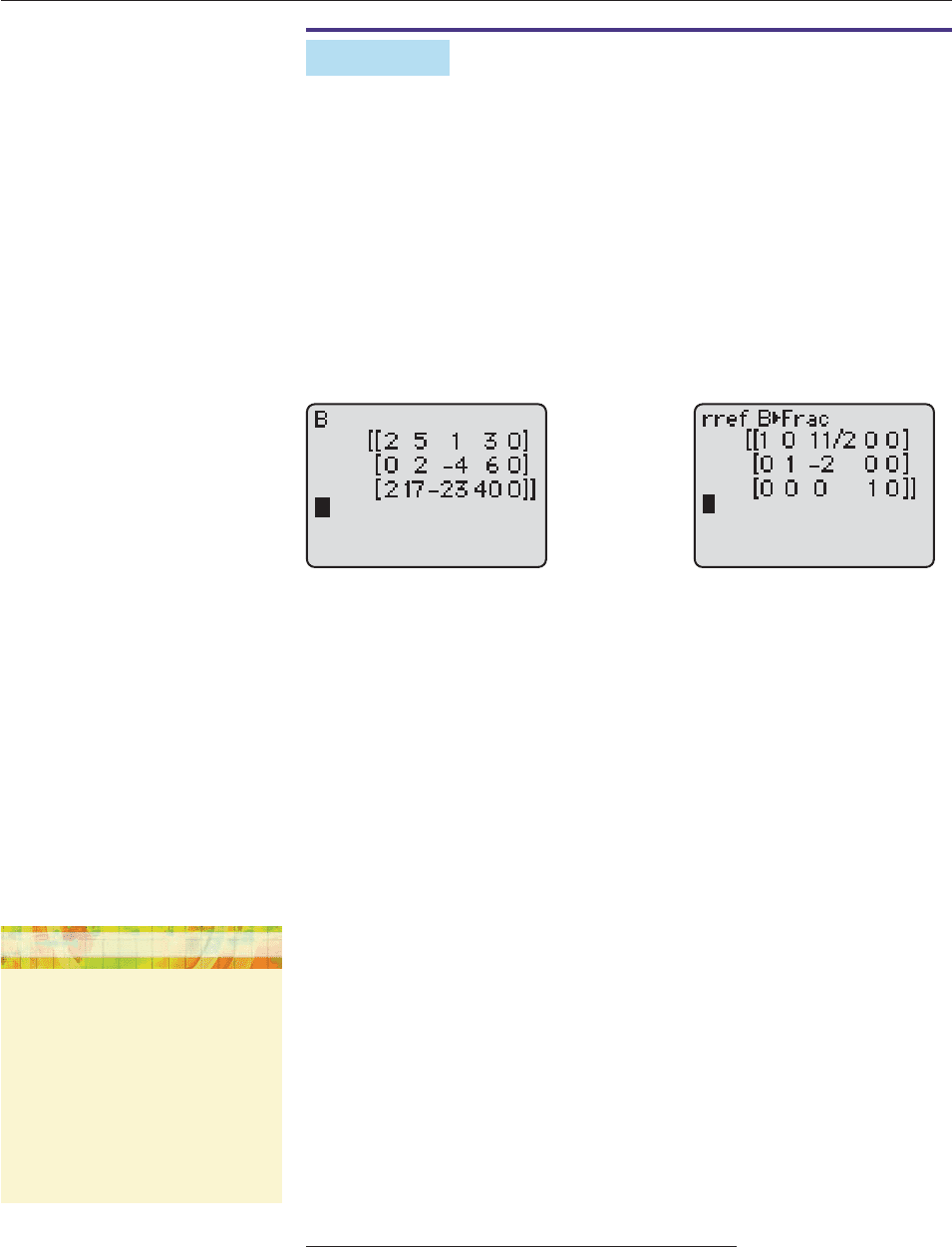
EXAMPLE 6
Solve this system.
2x 5y z 3w 0
2y 4z 6w 0
2x 17y 23z 40w 0.
SOLUTION A system such as this, in which all the constants on the right side
are zero, is called a homogeneous system. Every homogeneous system has at
least one solution, namely, x 0, y 0, z 0, w 0, which is called the trivial
solution. The issue with homogeneous systems is whether or not they have any
nonzero solutions. The augmented matrix of the system is shown in Figure 11–20,
and an equivalent reduced row echelon form matrix is shown in Figure 11–21.*
Figure 11–20 Figure 11–21
The system corresponding to the reduced echelon form matrix in Figure 11–21 is
x
1
2
1
z 0
y 2z 0
w 0.
The second equation shows that
y 2z.
This equation has an infinite number of solutions, for instance,
z 1, y 2orz 3, y 6orz 2.5, y 5.
In fact, for each real number t, there is a solution: z t, y 2t. Substituting
z t into the first equation shows that
x
1
2
1
t 0
x
1
2
1
t.
Therefore, this system, and hence the original one, has an infinite number of
solutions, one for each real number t.
x
1
2
1
t, y 2t, z t, w 0.
A system with infinitely many solutions, such as this one, is said to be dependent.
■
800 CHAPTER 11 Systems of Equations
*When dealing with homogeneous systems, it’s not really necessary to include the last column of
zeros, as is done here, because row operations do not change this column.
TECHNOLOGY TIP
If the TI-84 PolySmlt solver displays
the message
“No Solutions Found”,
press the RREF key at the bottom of
the screen to display the reduced row
echelon matrix of the system, from
which you can determine the solutions,
if any.
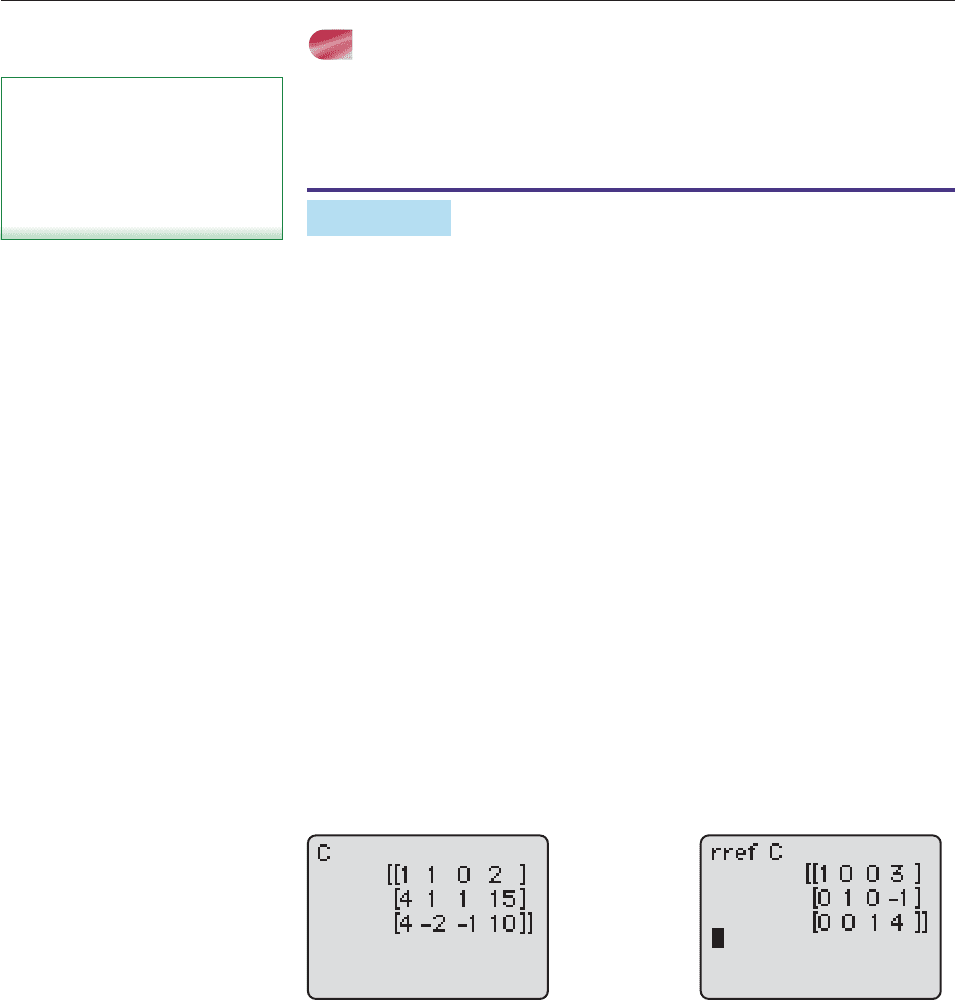
APPLICATIONS
In calculus, it is sometimes necessary to write a complicated rational expression
as the sum of simpler ones. One technique for doing this involves systems of
equations.
EXAMPLE 7
Find constants A, B, and C such that
2
(x
x
2
1)
1
(
5
x
x
2
1
)
2
0
x
A
1
x
B
2
(x
C
2)
2
.
SOLUTION Multiply both sides of the equation by the common denominator
(x 1)(x 2)
2
and collect like terms on the right side.
2x
2
15x 10 A(x 2)
2
B(x 1)(x 2) C(x 1)
A(x
2
4x 4) B(x
2
x 2) C(x 1)
Ax
2
4Ax 4A Bx
2
Bx 2B Cx C
(A B)x
2
(4A B C)x (4A 2B C).
Since the polynomials on the left and right sides of the last equation are equal,
their coefficients must be equal term by term, that is,
A B 2 [Coefficients of x
2
]
4A B C 15 [Coefficients of x]
4A 2B C 10. [Constant terms]
We can consider this as a system of equations with unknowns A, B, C. The aug-
mented matrix of the system is shown in Figure 11–22, and an equivalent reduced
row echelon form matrix is shown in Figure 11–23.
Figure 11–22 Figure 11–23
The solutions of the system can be read from the reduced row echelon form matrix
in Figure 11–23.
A 3, B 1, C 4.
Therefore,
2
(x
x
2
1)
1
(
5
x
x
2
1
)
2
0
x
3
1
x
1
2
(x
4
2)
2
.
The right side of this equation is called the partial fraction decomposition of the
fraction on the left side. ■
SECTION 11.2 Large Systems of Linear Equations 801
NOTE
Every system that has more variables
than equations (as in Example 6) is
dependent, but other systems may be
dependent as well.

EXAMPLE 8
Charlie is starting a small business and borrows $10,000 on three different credit
cards, with annual interest rates of 18%, 15%, and 9%, respectively. He borrows
three times as much on the 15% card as on the 18% card, and his total annual interest
on all three cards is $1244.25. How much did he borrow on each credit card?
SOLUTION Let x be the amount on the 18% card, let y be the amount on the
15% card, and let z be the amount on the 9% card. Then x y z 10,000. Fur-
thermore,
Interest on Interest on Interest on Total
18% card 15% card 9% card interest
.18x .15y .09z 1244.25.
Finally, we have
Amount on 3 times amount
15% card on 18% card
y 3x,
which is equivalent to 3x y 0. Therefore, we must solve this system of equa-
tions.
x y z 10,000
.18x .15y .09z 1,244.25
3x y 0,
whose augmented matrix is
1 1 1 10,000
.18 .15 .09 1,244.25
.
3 10 0.
The Calculator Exploration shows that Charlie borrowed $1275 on the 18% card,
$3825 on the 15% card, and $4900 on the 9% card. ■
The preceding examples illustrate the following fact, whose proof is omitted.
802 CHAPTER 11 Systems of Equations
——
——
———
———
——
——
Number of Solutions
of a System
Any system of linear equations must have
No solutions (an inconsistent system) or
Exactly one solution or
An infinite number of solutions (a dependent system).
Enter this matrix in your calculator. Use row operations or the RREF key to put it in
reduced row echelon form. Read the solutions of the system from this last matrix.
CALCULATOR EXPLORATION

SECTION 11.2 Large Systems of Linear Equations 803
EXERCISES 11.2
In Exercises 1–4, write the augmented matrix of the system.
1. 2x 3y 4z 1
x 2y 6z 0
3x 7y 4z 3
2. 4x y z 7w 4
x 4y 3w 0
5x 5z 10w 3
3. 2x
5
2
y
2
3
z 0
x
1
4
y 4z 0
3y
1
2
z 0
4. x 7y
2
5
z
5
6
w 0
1
8
x y 8z 1
2
3
y 5z w 2
1
6
x 4y
2
7
z 3
In Exercises 5–8, the augmented matrix of a system of equa-
tions is given. Express the system in equation notation.
3 54
5.
972
2 350
6.
7015
10101
7.
1 1423
42502
1026
8.
0541
8 234
In Exercises 9–12, the reduced row echelon form of the aug-
mented matrix of a system of equations is given. Find the solu-
tions of the system.
In Exercises 13–16, use Gaussian elimination to solve the
system.
13. x 3y 2z 0 14. 2x 3y 2z 8
2x y z 33x 2y z 3
x 2y 3z 0 x 2y 3z 1
15. x y z 1 16. 2x z 3
x 2y 2z 48x y 4z 1
2x y 3z 54x y 6z 7
In Exercises 17–20, use the Gauss-Jordan method to solve the
system.
17. x 2y 4z 6
x y 13z 6
2x 6y z 10
18. 5x 2y 3z 31
2x y 7z 10
x y 2z 3
19. x y z 200 20. 2x 4y z 2
x 2y 0 x y 5z 3
2x 3y 5z 600
2x y z 200
In Exercises 21–36, solve the system.
21. 11x 10y 9z 5
x 2y 3z 1
3x 2y z 1
22. 2x y 1
x 3y 5
3x 5y 7
23. 5x y 7 24. 6x 2y z 4
x y 53x 2z 0
4x 2y 23x 8y 14z 1
25. x 4y 13z 4 26. 3x y 4z 2
x 2y 3z 24x 2y 2
3x 5y 4z 22x y 8z 2
27. 4x y 3z 7 28. 2x 5y 3z 5
x y 2z 35x 8y 2z 2
3x 2y z 4 x 18y 8z 8
29. x y z 0 30. 3x y 4z 0
3x y z 0 x y 3z 0
5x y z 02x y 5z 0
10003/2
0100 5
9.
0010 2
0001 0
10023
01035
11.
00102
00000
10001
0100 3
10.
0010 1
0000 1
1002
010 3
12.
001 0
000 0
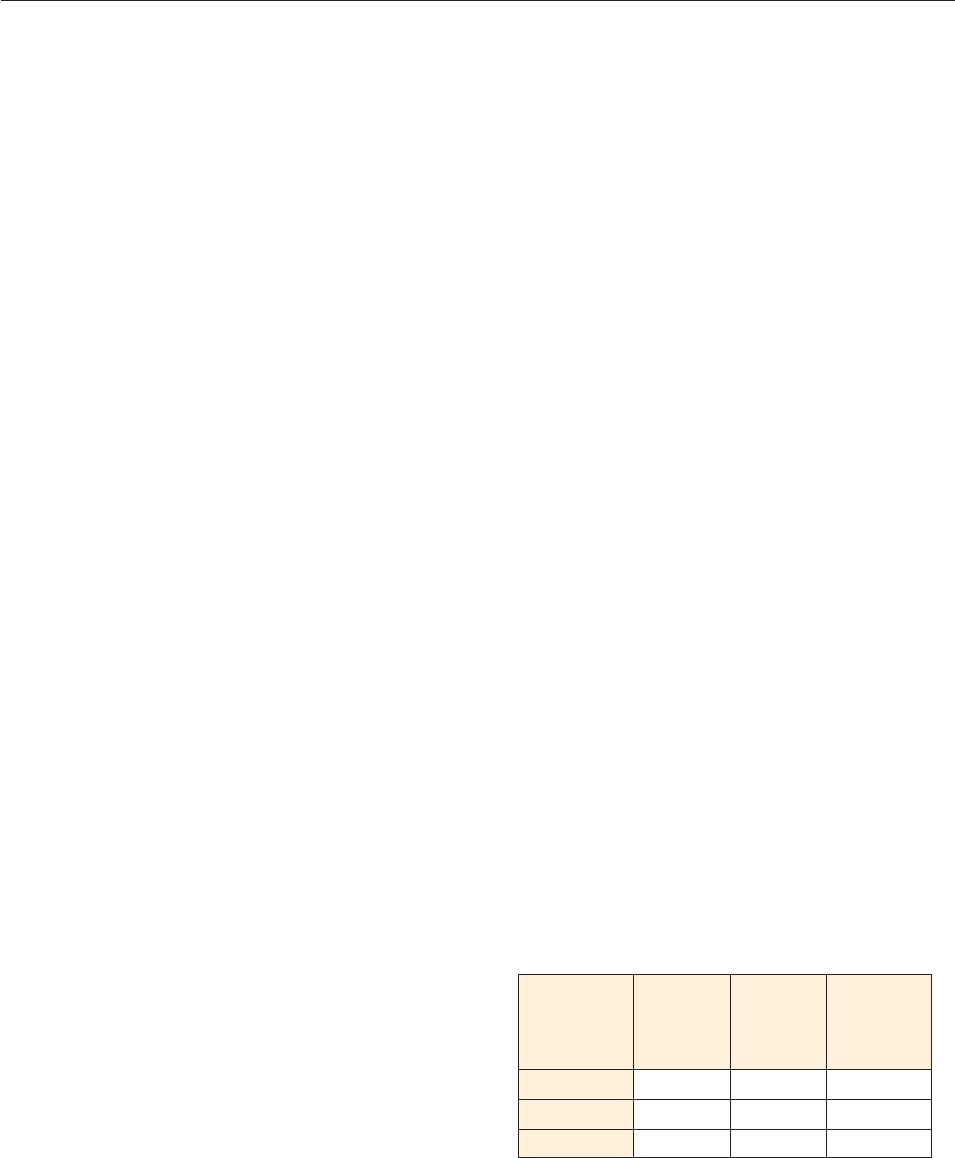
804 CHAPTER 11 Systems of Equations
31. 2x y 3z 2w 6
4x 3y z w 2
x y z w 5
2x 2y 2z 2w 10
32. x 7y z 2w 24
5x 3y 8z 7
x 4y 7z w 6
3y 4z w 2
33. x 2y z 3w 3
x y z 0
4y 3z 2w 1
2x 2y w 1
34. 2x 7y 2z 2w 6
3x 2y z 14
x 4y 7z 3w 4
x 3y 4z w 1
35.
3
x
1
y
4
z
13
1
x
2
y
1
z
12
4
x
1
y
3
z
7
[Hint: Let u 1/x, v 1/y, w 1/z.]
36.
x
1
1
y
2
3
z
3
2
4
y
5
3
z
1
0
2
5
x
3
1
y
4
3
z
1
2
2
[Hint: Let u 1/(x 1), v 1/(y 3), w 1/(z 2).]
Exercises 37–40, solve the system. [Note: The REF and RREF
keys on some calculators produce an error message when there
are more rows than columns in a matrix, in which case you will
have to solve the system by some other means.]
37. 2x y 1 38. x y 3
3x y 2 x 2y 3
4x 2y 25x y 3
5x 5y 4 7x 5y 3
39. x 2y 3 40. x y 2
2x 3y 4 x y 4
3x 4y 52x 3y 9
4x 5y 63x 2y 6
In Exercises 41–46, find the constants A, B, and C.
41.
(x 1
4
)(
x
x 3)
x
A
1
x
B
3
42.
(x 1)
1
(x 1)
x
A
1
x
B
1
43.
(x
2
2
x
)
(x
1
3)
2
x
A
2
x
B
3
(x
C
3)
2
44.
(2x
x
2
1)
x
(x
2
21
4)
2x
A
1
B
x
x
2
4
C
45.
x
A
1
x
2
B
x
x
C
1
46.
x
A
4
x
2
B
x
2
x
C
2
47. Lillian borrows $10,000. She borrows some from her friend
at 8% annual interest, twice as much as that from her bank
at 9%, and the remainder from her insurance company at
5%. She pays a total of $830 in interest for the first year.
How much did she borrow from each source?
48. An investor puts a total of $25,000 into three very specula-
tive stocks. She invests some of it in Crystalcomp and
$2000 more than one-half that amount in Flyboys. The re-
mainder is invested in Zumcorp. Crystalcomp rises 16% in
value, Flyboys rises 20%, and Zumcorp rises 18%. Her in-
vestment in the three stocks is now worth $29,440. How
much was originally invested in each stock?
49. An investor has $70,000 invested in a mutual fund, bonds,
and a fast food franchise. She has twice as much invested in
bonds as in the mutual fund. Last year the mutual fund paid
a 2% dividend, the bonds paid 10%, and the fast food fran-
chise paid 6%; her dividend income was $4800. How much
is invested in each of the three investments?
50. Tickets to a band concert cost $2 for children, $3 for
teenagers, and $5 for adults. 570 people attended the con-
cert and total ticket receipts were $1950. Three-fourths as
many teenagers as children attended. How many children,
adults, and teenagers attended?
51. The table shows the calories, sodium, and protein in one cup
of various kinds of soup.
How many cups of each kind of soup should be mixed
together to produce ten servings of soup, each of which
provides 203 calories, 1190 milligrams of sodium, and
x 2
(x 4)(x
2
2x 2)
5x
2
1
(x 1)(x
2
x 1)
Progresso Healthy Campbell’s
Roasted Choice Chunky
Chicken Hearty Chicken
Rotini Chicken Noodle
Calories 100 130 130
Sodium (mg) 970 480 880
Protein (g) 68 8
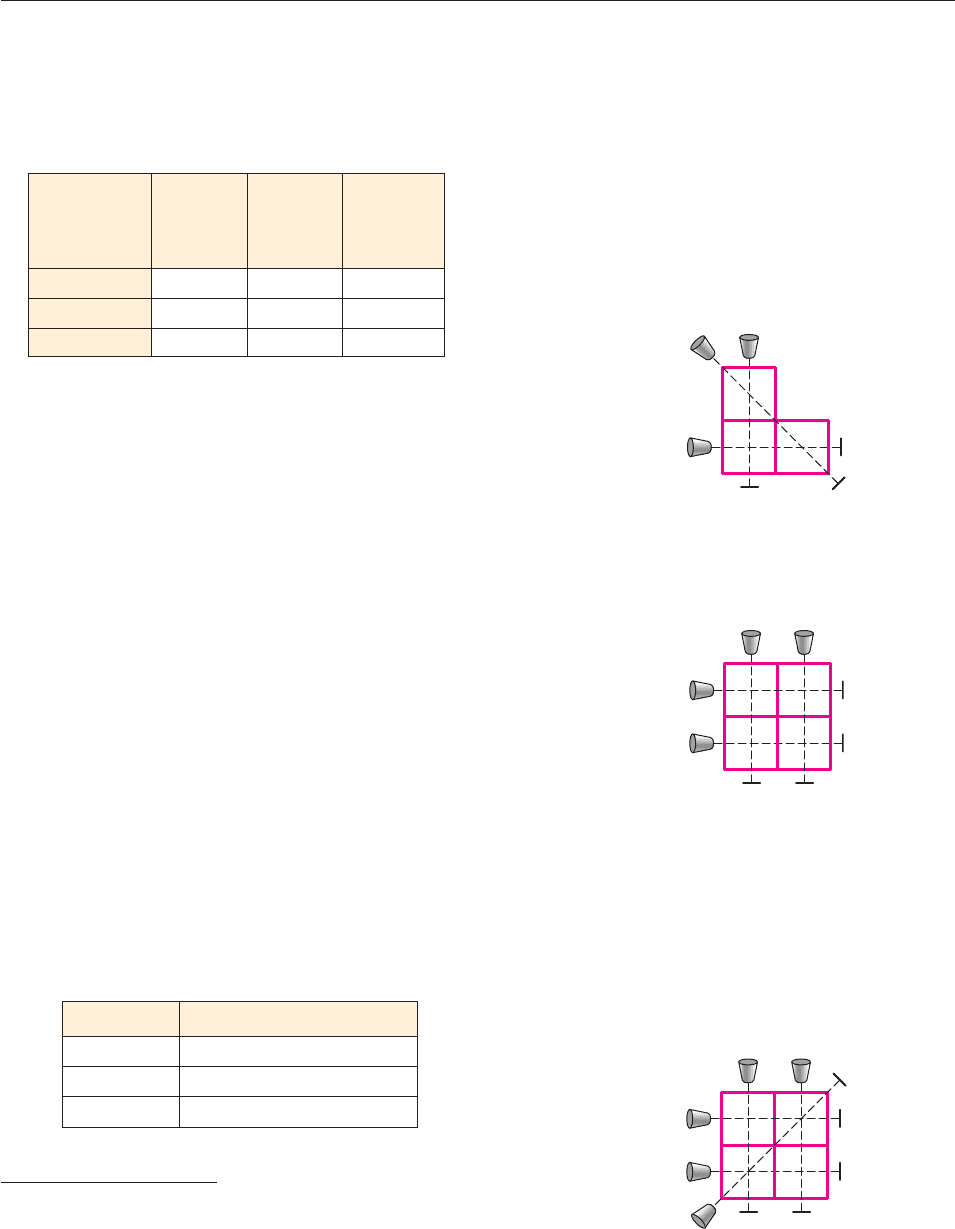
SECTION 11.2 Large Systems of Linear Equations 805
12.4 grams of protein? What is the serving size (in cups)?
(Hint: In ten servings, there must be 2030 calories, 11,900
milligrams of sodium, and 124 grams of protein.)
52. The table shows the calories, sodium, and fat in one ounce
of various snack foods (all produced by Planters).
How many ounces of each kind of snack should be com-
bined to produce ten servings, each of which provides
220 calories, 188 milligrams of sodium, and 17.4 grams of
fat? What is the serving size?
53. Comfort Systems, Inc., sells three models of humidifiers.
The bedroom model weighs 10 pounds and comes in an 8-
cubic-foot box; the living-room model weighs 20 pounds
and comes in an 8-cubic-foot box; the whole-house model
weighs 60 pounds and comes in a 28-cubic-foot box. Each
of the company’s delivery vans has 248 cubic feet of space
and can hold a maximum of 440 pounds. For a van to be as
fully loaded as possible, how many of each model should it
carry?
54. Peanuts cost $3 per pound, almonds cost $4 per pound, and
cashews costs $8 per pound. How many pounds of each
should be used to produce 140 pounds of a mixture costing
$6 per pound, in which there are twice as many peanuts as
almonds?
Exercises 55 and 56 deal with computer-aided tomography
(CAT) scanners that take X-rays of body parts from different
directions to create a picture of a cross section of the body.*
The amount by which the X-ray energy decreases (measured
in linear-attenuation units) indicates whether the X-ray has
passed through healthy tisue, tumorous tissue, or bone,
according to the following table.
The body part being scanned is divided into cells. The total
linear-attenuation value is the sum of the values for each cell
the X-ray passes through. In the figure for Exercise 55, for
example, let a, b, and c be the values for cells A, B, and C,
respectively; then the attenuation value for X-ray 3 is b c.
55. (a) In the figure, find the linear-attenuation values for
X-rays 1 and 2.
(b) If the total linear-attenuation values for X-rays 1, 2, and
3 are .75, .60, and .54, respectively, set up and solve a
system of three equations in a, b, c.
(c) What kind of tissue are cells A, B, and C?
56. Four X-ray beams are aimed at four cells, as shown in the
figure.
(a) If the total linear-attenuation values for X-rays 1, 2, 3,
and 4 are .60, .75, .65, and .70, respectively, is there
enough information to determine the values of a, b, c,
and d? Explain.
(b) If an additional X-ray beam is added, with a linear-
attenuation value of .85, as shown in the figure below,
can the values of a, b, c, and d be determined? If so, what
are they? What can be said about cells A, B, C, and D?
X-ray
1
X-ray 4
X-ray 5
X-ray 3
AC
BD
X-ray
2
X-ray
1
X-ray 4
X-ray 3
AC
BD
X-ray
2
X-ray 2
X-ray 1
X-ray 3
A
BC
Dry
Roasted Cajun
Honey Crunch
Cashews Peanuts Trail Mix
Calories 170 150 160
Sodium (mg) 115 110 270
Fat (g) 14 12 11
Tissue Type Linear-Attenuation Units
Healthy .1625–.2977
Tumorous .2679–.3930
Bone .3857–.5108
*Exercises 55 and 56 are based on D. Jabon, G. Nord, B. W. Wilson, and
P. Coffman, “Medical Applications of Linear Equations,” Mathematics
Teacher 89, no. 5 (May 1996).
